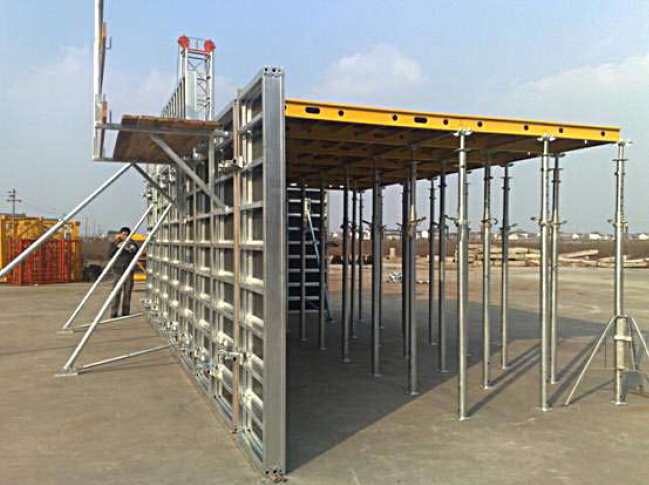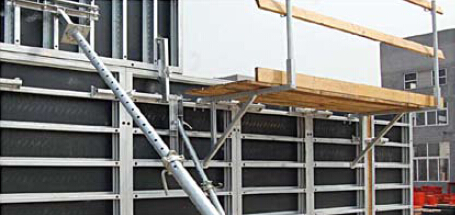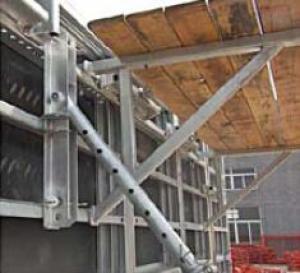Steel-frame working platformfor Formwork and Scaffolding system
- Loading Port:
- Tianjin
- Payment Terms:
- TT OR LC
- Min Order Qty:
- 50 m²
- Supply Capability:
- 1000 m²/month
OKorder Service Pledge
OKorder Financial Service
You Might Also Like
Steel-frame Formwork SF-140
Characteristics:
◆ Few parts for fast forming.
◆ Max. Concrete pressure: 80KN/m2.
◆ Hot-dip galvanized steel frame.
◆ The thickness of plywood is 18mm & the panel is 14cm.
◆ Compatibility with Hunnebeck Manto system due to similar edge profile.
System Details & Application:
◆ Neat joint and fast assembling with aligning panel clamp.
◆ Flexible panel arrangement and height extension.
◆ The selection of panels.
◆ Kinds of panel connectors.
◆ Corner clamp application.
◆ Length adjustment application.
◆ Height adjustment & aligning strut.
◆ Walkway bracket & platform.


- Q:How long does it take to set up steel formwork?
- The time required to set up steel formwork varies depending on several factors. These factors include the complexity of the structure, the level of experience and skill of the workers, the size of the project, and the availability of equipment. In general, the setup of steel formwork can take anywhere from a few hours to several days. For smaller projects with simple structures, a team of experienced workers can usually complete the formwork setup within a day or two. This involves tasks like measuring and marking the layout, assembling the steel panels, beams, and props, and securing them in place. Additionally, braces and ties may be attached to ensure stability and alignment. On the other hand, larger and more intricate projects may require more time for formwork setup. These projects may include complex designs, multiple levels or floors, and a greater number of formwork components. In such cases, the setup process may take several days or even weeks, depending on the size of the team and the availability of resources. It is worth noting that although steel formwork may take longer to set up compared to other types of formwork like timber or plastic, it offers advantages such as durability, reusability, and enhanced stability. These benefits outweigh the additional time required for setup, particularly for large-scale construction projects that necessitate robust and dependable formwork systems.
- Q:How does steel formwork handle vibrations from construction equipment?
- Steel formwork is known for its exceptional strength and durability, making it highly capable of handling vibrations from construction equipment. The rigidity and stability of steel formwork allow it to effectively absorb and distribute vibrations, minimizing their impact on the structure being built. Steel formwork consists of interconnected steel panels, which are securely fastened together to create a sturdy framework. This interconnected design helps to dissipate vibrations throughout the entire formwork system, preventing concentrated impact on any specific area. As a result, the vibrations are dispersed and absorbed, without causing any significant damage to the formwork or the concrete being poured. Moreover, steel formwork has a high load-bearing capacity, enabling it to withstand the weight and vibrations generated by heavy construction equipment. The robust nature of steel ensures that it remains intact and stable, even under intense vibrations. Additionally, steel formwork provides an advantage over other materials, such as timber, in terms of its resistance to warping or deformation caused by vibrations. The structural integrity of steel is maintained, even when subjected to repetitive or intense vibrations, ensuring the accuracy and stability of the formwork system. Overall, steel formwork is an ideal choice for handling vibrations from construction equipment due to its strength, stability, and ability to absorb and distribute vibrations effectively. Its durability and resistance to warping make it a reliable solution for withstanding the rigorous demands of construction projects.
- Q:How does steel formwork contribute to the overall sustainability of the construction industry?
- There are several ways in which steel formwork contributes to the overall sustainability of the construction industry. Firstly, its durability and long-lasting nature allow for multiple reuses, reducing the need for new formwork materials each time a construction project is undertaken. This, in turn, significantly reduces waste generation during the construction process and minimizes the industry's overall environmental impact. In addition, steel formwork offers a more sustainable alternative to traditional materials like timber. The use of timber often involves cutting down trees, leading to deforestation and habitat destruction. By opting for steel formwork, we can decrease our reliance on timber and contribute to the preservation of forests. Moreover, steel formwork provides greater structural stability and strength compared to other materials. This enables more efficient construction processes and reduces the necessity for additional support structures. Consequently, less material is wasted, energy is conserved, and the overall construction time is shortened, resulting in a more sustainable process. Furthermore, steel formwork exhibits exceptional resistance to weather conditions, corrosion, and fire. This ensures the longevity of buildings, thus reducing the need for frequent repairs or replacements. By utilizing steel formwork, we can construct structures with extended lifespans, leading to reduced resource consumption and waste generation over time. Lastly, steel formwork is recyclable. At the end of its lifecycle, it can be easily melted down and repurposed for other applications. This diminishes the demand for new steel production, conserves natural resources, and lowers energy consumption. To sum up, steel formwork's durability, reusability, resistance to weather conditions, and recyclability all contribute to the overall sustainability of the construction industry. By minimizing waste generation, deforestation, energy consumption, and resource depletion, its use proves to be an environmentally-friendly choice for construction projects.
- Q:How does steel formwork handle concrete vibration and air entrapment?
- Steel formwork is well-suited for handling concrete vibration and air entrapment due to its strength and rigidity. Unlike other formwork materials, steel does not deform or buckle under the pressure of concrete vibration, providing a stable structure for the pouring and curing process. Additionally, steel formwork is designed with tight joints and smooth surfaces, minimizing the risk of air entrapment and ensuring proper concrete consolidation. Overall, steel formwork effectively handles concrete vibration and air entrapment, resulting in high-quality and durable concrete structures.
- Q:Can steel formwork be used for precast concrete arches?
- Yes, steel formwork can be used for precast concrete arches. Steel formwork provides a strong and durable structure for shaping and supporting the concrete during the casting process. It allows for the creation of precise and complex arch shapes, ensuring the desired architectural and structural requirements are met. Additionally, steel formwork can be easily customized and reused, making it a cost-effective option for precast concrete arches.
- Q:Can steel formwork be used for both horizontal and vertical concrete elements?
- Yes, steel formwork can be used for both horizontal and vertical concrete elements. Steel formwork provides strength, stability, and durability, making it suitable for a wide range of construction projects. Its versatility allows for the creation of various shapes and sizes, making it a preferred choice for both horizontal slabs and vertical walls.
- Q:How does steel formwork accommodate for different concrete curing durations?
- Steel formwork can accommodate for different concrete curing durations by providing a sturdy and durable structure that can support the weight of the concrete during the curing process. The steel formwork is designed to be reusable, allowing for easy removal once the concrete has cured to the desired strength. This flexibility in formwork material enables construction projects to adapt to different curing durations without compromising the structural integrity of the concrete.
- Q:Can steel formwork be used for both cast-in-place and precast concrete construction?
- Yes, steel formwork can be used for both cast-in-place and precast concrete construction. Steel formwork is versatile and can be easily adjusted and modified to suit different construction methods. In cast-in-place construction, steel formwork is commonly used to create temporary molds or frameworks that hold the liquid concrete in place until it hardens and gains strength. Once the concrete is set, the formwork can be removed and reused for subsequent pours. In precast concrete construction, steel formwork is used to create permanent molds or frameworks that shape the concrete elements off-site. These precast elements are then transported to the construction site and installed as a part of the overall structure. Steel formwork is highly durable and can withstand the high pressures and forces involved in precast concrete construction. Overall, steel formwork offers numerous advantages such as strength, durability, reusability, and adaptability, making it suitable for both cast-in-place and precast concrete construction methods.
- Q:What are the safety considerations when working with steel formwork?
- When working with steel formwork, there are several safety considerations that should be taken into account to ensure the well-being of workers and the overall success of the project. First and foremost, it is important to provide proper training to all workers who will be involved in handling and installing steel formwork. This training should include instruction on how to safely handle heavy steel panels, as well as how to correctly assemble and dismantle the formwork system. Workers should also be educated on the potential hazards associated with steel formwork, such as the risk of falling objects or pinch points between panels, and how to mitigate these risks. Another important safety consideration is the use of appropriate personal protective equipment (PPE). Workers should be provided with and required to wear PPE such as hard hats, safety glasses, steel-toed boots, and gloves to protect themselves from potential hazards. It is also crucial to ensure that the PPE is in good condition and properly fitted to each worker. Proper planning and organization are key to maintaining safety on a steel formwork site. This includes conducting thorough risk assessments before starting any work, identifying potential hazards, and implementing control measures to minimize risks. It is important to establish designated walkways and clear access routes to prevent tripping hazards and ensure safe movement around the site. Regular inspections of the steel formwork system should be conducted to identify any signs of damage or deterioration. Any damaged or defective components should be promptly repaired or replaced to maintain the structural integrity and safety of the formwork. Lastly, communication and coordination among workers are essential for a safe working environment. Clear communication channels and procedures should be established to ensure that everyone is aware of potential hazards and can promptly report any safety concerns. By prioritizing training, providing proper PPE, planning and organizing the work site, conducting regular inspections, and promoting effective communication, the safety considerations when working with steel formwork can be effectively addressed, reducing the risk of accidents and injuries.
- Q:Can steel formwork be used in extreme weather conditions?
- Yes, steel formwork can be used in extreme weather conditions. Steel is a durable and resilient material that can withstand harsh weather elements such as extreme temperatures, heavy rain, strong winds, and even snow. It provides a stable and reliable support system for concrete construction projects, ensuring structural integrity regardless of the weather conditions.
1. Manufacturer Overview |
|
|---|---|
| Location | |
| Year Established | |
| Annual Output Value | |
| Main Markets | |
| Company Certifications | |
2. Manufacturer Certificates |
|
|---|---|
| a) Certification Name | |
| Range | |
| Reference | |
| Validity Period | |
3. Manufacturer Capability |
|
|---|---|
| a)Trade Capacity | |
| Nearest Port | |
| Export Percentage | |
| No.of Employees in Trade Department | |
| Language Spoken: | |
| b)Factory Information | |
| Factory Size: | |
| No. of Production Lines | |
| Contract Manufacturing | |
| Product Price Range | |
Send your message to us
Steel-frame working platformfor Formwork and Scaffolding system
- Loading Port:
- Tianjin
- Payment Terms:
- TT OR LC
- Min Order Qty:
- 50 m²
- Supply Capability:
- 1000 m²/month
OKorder Service Pledge
OKorder Financial Service
Similar products
New products
Hot products
Related keywords























